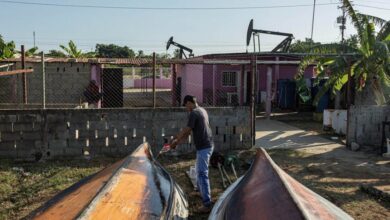Green Investment in Latin America’s Environmental Future

Foreign direct investment (FDI) is transforming Latin America’s energy landscape, driving the transition from fossil fuels to renewable resources. While this shift is promising, it requires careful consideration of historical context and sustainability to ensure long-term ecological benefits.
Latin America has long been a region rich in natural resources, from the silver mines of colonial Peru to the vast oil fields of Venezuela. However, this wealth has often come at a high environmental cost. The extraction of resources has historically been driven by foreign interests, leading to significant ecological degradation. Latin America has served as a battleground for external powers vying for control over its abundant natural wealth for centuries. This legacy of exploitation has left deep scars on the region’s environment, from deforestation in the Amazon to pollution in mining regions.
As Latin America enters the 21st century, the focus will shift from resource extraction to environmental preservation and sustainability. The global push for reducing carbon emissions and transitioning to renewable energy sources has placed the region at the forefront of the green economy movement. However, the question remains: can foreign financial inflows, primarily through foreign direct investment (FDI), truly benefit Latin America’s environment, or will it repeat the patterns of the past?
This feature delves into the role of FDI in Latin America’s transition towards renewable energy, examining its impact on the region’s ecological footprint and load capacity factor—two key environmental sustainability indicators. By analyzing data from 1990 to 2022 across 17 Latin American countries, the study reveals how FDI has influenced environmental quality and highlights the need for a nuanced approach to green investment.
A Double-Edged Sword in the Quest for Sustainability
Foreign direct investment (FDI) has long been a driving force behind economic development in Latin America. Recently, as global awareness of climate change has grown, FDI has increasingly been directed towards environmental technologies and renewable energy projects. Countries like Brazil, Mexico, and Chile have become hotspots for renewable energy investments, attracting billions of dollars in FDI to harness the region’s abundant wind, solar, and hydroelectric potential.
However, the impact of these investments on the environment is complex. On the one hand, FDI has undoubtedly contributed to the growth of renewable energy infrastructure in Latin America. The development of wind farms in Patagonia, solar plants in the Atacama Desert, and hydropower projects in the Amazon Basin are testaments to the region’s commitment to clean energy. These projects have the potential to significantly reduce greenhouse gas emissions and promote sustainable development.
On the other hand, the study’s findings suggest that the interaction between FDI and environmental technologies has had a minimal impact on improving environmental quality. While FDI has helped to establish renewable energy infrastructure, it has not always led to a reduction in the ecological footprint. This indicates that while green investments are a step in the right direction, they are not a panacea for the region’s environmental challenges.
This paradox highlights the importance of implementing measures to ensure that FDI contributes positively to environmental sustainability. The study suggests that a more targeted approach is needed, one that focuses not only on the development of renewable energy technologies but also on the broader ecological impact of these investments. Without careful planning and regulation, there is a risk that FDI could exacerbate existing environmental problems rather than solve them.
A New Path for Latin America
The transition from fossil fuels to renewable energy is not just an environmental imperative for Latin America—it is also an economic one. The region’s reliance on oil, gas, and coal has made it vulnerable to the fluctuations of global energy markets, as well as the environmental damage associated with fossil fuel extraction and consumption. By investing in renewable energy, Latin America has the opportunity to diversify its energy sources, reduce its carbon footprint, and create a more sustainable economic future.
The study’s analysis reveals that the adoption and adaptation of renewable infrastructure in Latin America have had a positive effect on environmental sustainability. Countries that have embraced renewable energy technologies, such as Uruguay and Costa Rica, have seen significant reductions in their ecological footprints and improvements in their load capacity factors. These successes demonstrate the potential of renewable energy to transform Latin America’s environmental landscape.
However, the transition to renewable energy is not without its challenges. The study emphasizes the need for substantial financing to advance the energy transition. While FDI has played a crucial role in jumpstarting renewable energy projects, the region will need to attract even more investment to meet its sustainability goals. According to the International Renewable Energy Agency (IRENA), investment levels will need to double by 2030 and triple thereafter to achieve the desired outcomes.
Moreover, the study highlights the importance of aligning FDI with national strategies and the specific characteristics of each country’s energy market. Latin America is a diverse region with varying levels of development, infrastructure, and natural resources. As such, a one-size-fits-all approach to green investment is unlikely to be effective. Instead, tailored strategies that take into account the unique needs and capabilities of each country are essential for ensuring that FDI contributes to sustainable development.
The Future of Green Investment in Latin America
As Latin America continues its journey towards environmental sustainability, the role of foreign direct investment will be critical. The study underscores the necessity of promoting green FDI that not only supports the development of renewable energy infrastructure but also contributes to broader environmental goals. This requires a holistic approach that considers the long-term impact of investments on the region’s ecological health.
To achieve this, Latin American countries must implement policies that attract and regulate green FDI effectively. This includes offering incentives for investments in renewable energy, ensuring that projects comply with environmental standards, and promoting the transfer of clean technologies. Additionally, governments should focus on building local capacities to develop and maintain renewable energy infrastructure, thereby reducing dependency on foreign expertise and fostering sustainable economic growth.
The study also calls for greater collaboration between the public and private sectors to maximize the benefits of green FDI. By working together, governments, businesses, and international organizations can create a supportive environment for sustainable investment that balances economic development with environmental preservation.
Also read: Mexico Leads AI Expansion in Latin America Amid Challenges
While FDI has the potential to drive Latin America’s transition to a green economy, its success will depend on how it is managed and implemented. The study’s findings suggest that simply increasing FDI in renewable energy is not enough; a more strategic approach is needed to ensure that these investments lead to real environmental improvements. By focusing on sustainability, innovation, and local development, Latin America can harness the power of FDI to build a more sustainable future for the region and the planet.




